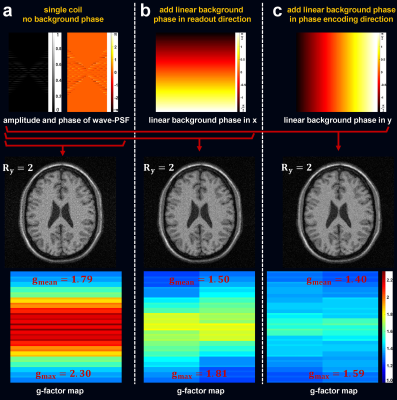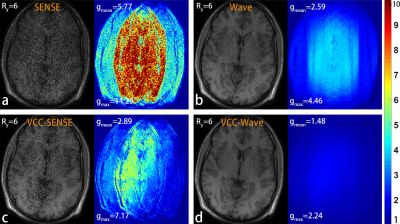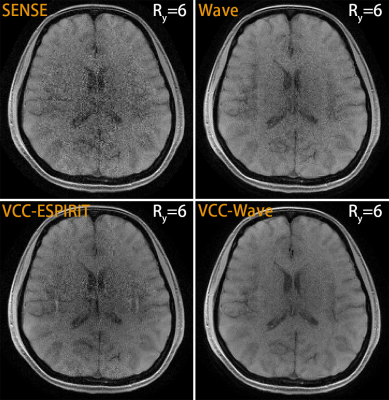1159
VCC-Wave for Improved Parallel MRI of High Resolution and High Bandwidth1Shenzhen Institutes of Advanced Technology, Chinese Academy of Sciences, Shenzhen, China, 2University of Chinese Academy of Sciences, Beijing, China
Synopsis
Wave encoding is less efficient in situations of high resolution and high bandwidth. In this work, a novel model (named as VCC-Wave) which combines virtual conjugate coil (VCC) and wave encoding (Wave) was proposed. It can not only combine both advantages of VCC and Wave, but also exploit more priors of Wave under the VCC framework. Further significant improvement is achieved, and the limitation of Wave in situations of high resolution and high bandwidth is alleviated.
Introduction
Wave-CAIPI technique1,2 utilizes the spatial variation of 3D coil sensitivity by causing aliasing in all three dimensions. It combines bunched phase encoding (BPE)3 and CAIPIRINHA.4,5 Wherein, BPE employs sinusoidal (wave) gradients to cause spreading aliasing along the readout (RO) direction. It is referred to as wave encoding (shortened as Wave), and is characterized by the wave-point spread function (PSF). As systematically investigated in Polak et al6 and Wang et al,7 the wave gradients largely affect the performance of Wave. Specifically, the g-factor reduction due to Wave is mainly governed by the wave gradient amplitude, resolution, bandwidth and field-of-view (FOV).7 However, specifically, Wave is less efficient in situations of high resolution and high bandwidth. Virtual Conjugate Coil (VCC)8,9 is another technique that improves the system condition of the encoding matrix in parallel MRI. The idea is incorporating the object background- and coil-phase into the reconstruction process, to provide additional encoding power. width. Recently, we found that VCC can also utilize the phase variations along RO when incorporating Wave. Besides, the wave-PSF as a controllable phase can also be utilized by VCC. That is, the VCC framework can exploit more priors from Wave, besides the well-known priors from Wave and VCC. With these, the system condition of the encoding matrix in parallel MRI can be significantly improved. Therefore, we propose to combine VCC and Wave (named as VCC-Wave) to improve the performance of the Wave technique and naturally alleviate the limitation of Wave in situations of high resolution and high bandwidth.Methods
A step-by-step simulation experiment was performed to illustrate the improvements provided by exploiting additional priors in the proposed VCC-Wave model. The experiment considers a single coil with homogeneous uniform sensitivity and 2-fold regular k-space under-sampling. Three cases were simulated step by step: 1) without background phase; 2) with linear background phase along RO; 3) with linear background phase along both RO and PE. In addition, the simulation experiment of multiple coils was conducted to compare the proposed VCC-Wave to the competing methods. Comparison experiments were performed between VCC-Wave and the relevant methods: SENSE, Wave and VCC-SENSE. To evaluate the proposed VCC-Wave in situations of high resolution and high bandwidth, two in vivo human brain experiments were performed. The IRB approved studies were conducted on a 3T uMR 790 system (United Imaging Healthcare, Shanghai, China) using a commercial 24-channel head coil. For reconstruction, the ESPIRiT12 algorithm using 2 sets of maps, which has been used for VCC-based parallel imaging problem,9,13 was chosen for the proposed VCC-Wave. For comparison, three competing methods: SENSE, Wave and VCC-ESPIRiT, were also conducted.Results
As shown in Fig. 2~4, the reconstructed image in SESNE is submerged in severe noise, as expected. However, the Wave technique achieves small improvement compared to SENSE. It is also disturbed by severe noise. This is because Wave is less efficient in the situation of high resolution. Specifically, only a small wave relative amplitude can be reached in this situation. VCC achieves noticeable improvement than SENSE in image SNR. However, residual artifacts still occur in the reconstructed image. The proposed VCC-Wave model can achieve significant improvement and thus alleviate the limitation of Wave.Discussion
The proposed VCC-Wave model intends to improve the system condition of the encoding matrix in parallel imaging. Nevertheless, it can be extended to more general models that contain regularizations, e.g. sparsity and low rank constraints, similar to Wave-CS20,21 and Wave-LORAKS.22Acknowledgements
Zhilang Qiu and Sen Jia contributed equally to this work. This work was supported in part by the National Key R&D Program of China (No. 2017YFC0108802 and 2017YFC0112903), the Strategic Priority Research Program of Chinese Academy of Sciences (No.XDB25000000), the Pearl River Talent Recruitment Program of Guangdong Province (No.2019QN01Y986), the Shenzhen Peacock Plan Team Program (No.KQTD20180413181834876), the Chinese Academy of Sciences Engineering Laboratory for Medical Imaging Technology and Equipment (No.KFJ-PTXM-012), the Shenzhen Key Laboratory of Ultrasound Imaging and Therapy (No. ZDSYS201802061806314), the Natural Science Foundation of Guangdong Province (No.2018A0303130132) and the National Natural Science Foundation of China (No.61871373, No.81729003 and No.81901736). the State Key Program of the National Natural Science Foundation of China (Grant No. 81830056) and the Key Laboratory for Magnetic Resonance and Multimodality Imaging of Guangdong Province.References
1. Bilgic B, Gagoski BA, Cauley SF, Fan AP, Polimeni JR, Grant PE, Wald LL, Setsompop K. Wave-CAIPI for highly accelerated 3D imaging. Magn Reson Med 2015;73:2152-2162.
2. Gagoski BA, Bilgic B, Eichner C, Bhat H, Grant PE, Wald LL, Setsompop K. RARE/Turbo Spin Echo Imaging with Simultaneous Multislice Wave-CAIPI. Magn Reson Med 2015;73:929-938.
3. Moriguchi H, Duerk JL. Bunched Phase Encoding (BPE): A new fast data acquisition method in MRI. Magn Reson Med 2006;55:633-648.
4. Breuer FA, Blaimer M, Mueller MF, Seiberlich N, Heidemann RM, Griswold MA, Jakob PM. Controlled aliasing in volumetric parallel imaging (2D CAIPIRINHA). Magn Reson Med 2006;55:549-556.
5. Setsompop K, Gagoski BA, Polimeni JR, Witzel T, Wedeen VJ, Wald LL. Blipped-controlled aliasing in parallel imaging for simultaneous multislice echo planar imaging with reduced g-factor penalty. Magnet Reson Med 2012;67:1210-1224.
6. Polak D, Cauley S, Huang SY, Longo MG, Conklin J, Bilgic B, Ohringer N, Raithel E, Bachert P, Wald LL, Setsompop K. Highly-accelerated volumetric brain examination using optimized Wave-CAIPI encoding. J Magn Reson Imaging 2019;50:961-974.
7. Wang H, Qiu Z, Su S, Jia S, Li Y, Liu X, Zheng H, Liang D. Parameter optimization framework on wave gradients of Wave-CAIPI imaging. Magn Reson Med 2020;83:1659-1672.
8. Blaimer M, Gutberlet M, Kellman P, Breuer FA, Kostler H, Griswold MA. Virtual coil concept for improved parallel MRI employing conjugate symmetric signals. Magn Reson Med 2009;61:93-102.
9. Blaimer M, Heim M, Neumann D, Jakob PM, Kannengiesser S, Breuer FA. Comparison of phase-constrained parallel MRI approaches: Analogies and differences. Magn Reson Med 2016;75:1086-1099.
10 Uecker M, Lai P, Murphy MJ, Virtue P, Elad M, Pauly JM, Vasanawala SS, Lustig M. ESPIRiT-An Eigenvalue Approach to Autocalibrating Parallel MRI: Where SENSE Meets GRAPPA. Magn Reson Med 2014;71:990-1001.
11. Uecker M, Lustig M. Estimating Absolute-Phase Maps Using ESPIRiT and Virtual Conjugate Coils. Magnet Reson Med 2017;77:1201-1207.
20. Curtis AT, Bilgic B, Setsompop K, Menon RS, Anand CK. Wave-CS: Combining wave encoding and compressed sensing. In Proceedings of the 23th Annual Meeting of ISMRM, Toronto, Canada, 2015. p.82.
21. Bilgic B, Ye H, Wald LL, Setsompop K. Optimized CS-Wave imaging with tailored sampling and efficient reconstruction. In Proceedings of the 24th Annual Meeting of ISMRM, Singapore, 2016. p.612.
22. Kim TH, Bilgic B, Polak D, Setsompop K, Haldar JP. Wave-LORAKS: Combining wave encoding with structured low-rank matrix modeling for more highly accelerated 3D imaging. Magn Reson Med 2018;81:1620-1633.
23. Buehrer M, Pruessmann KP, Boesiger P, Kozerke S. Array compression for MRI with large coil arrays. Magn Reson Med 2007;57:1131-1139.
Figures



